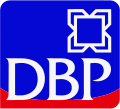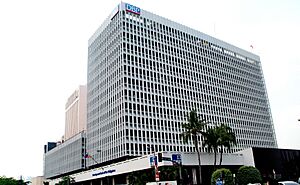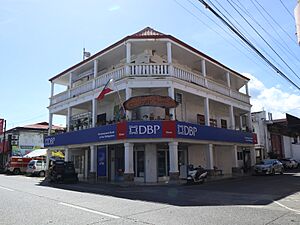Development Bank of the Philippines facts for kids
 |
|

DBP Head Office at Gil Puyat Avenue corner Makati Avenue, Makati
|
|
| Government financial institution | |
| Industry | Development finance |
| Founded | January 2, 1947 in Manila, Philippines |
| Headquarters | Makati, Philippines |
|
Key people
|
|
| Services | Financial Services |
| ₱5.60 billion (2019) | |
| Total assets | ₱1.04 trillion (2020) |
The Development Bank of the Philippines (DBP) is a special bank owned by the Philippine government. It helps grow the country's economy. DBP focuses on helping businesses in farming and industry. It also supports projects that improve people's lives.
DBP has its main office in Makati, Philippines. It has many branches across the country. As of 2023, DBP was one of the biggest banks in the Philippines. It is also one of the main government-owned banks.
Contents
How DBP Helps the Philippines
DBP was created after World War II in 1947. The government wanted to rebuild the country. DBP's main job is to provide money for important projects.
Supporting Key Areas
DBP focuses on four main areas to help the country:
- Infrastructure and Logistics: This means building roads, bridges, and other important structures. It also includes systems for moving goods and people.
- Social Services: Helping with things like health, education, and housing for communities.
- Small and Medium Enterprises (SMEs): Giving loans to smaller businesses. This helps them grow and create jobs.
- Environment: Supporting projects that protect nature and promote green practices.
DBP's Role as a Government Bank
DBP is a government-owned corporation. This means it is owned and managed by the government. Like other government corporations, DBP shares a part of its earnings with the National Government.
DBP's Journey Through Time
DBP's story began even before World War II. In 1935, a group called the National Loan and Investment Board (NLIB) was formed. It managed government money, like savings from postal services.
From AIB to RFC
In 1939, the NLIB's work was taken over by a new group. This was the Agricultural and Industrial Bank (AIB). The AIB continued its work until World War II started. After the war, in 1947, the government created the Rehabilitation Finance Corporation (RFC). The RFC took over from the AIB. Its job was to help rebuild the country. It gave loans for farming, trade, and industry. It also helped fix properties damaged by the war.
Becoming the DBP We Know Today
In 1958, the RFC changed its name to the Development Bank of the Philippines (DBP). This new name showed that the bank's work was growing. It was no longer just about rebuilding. It was now about helping the country develop in many ways.
DBP started with a capital of 500 million Philippine pesos. It quickly expanded its services. It opened branches all over the country. It also borrowed money from international banks. This helped DBP support national economic growth.
Challenges and New Beginnings
In the late 1970s and early 1980s, DBP faced some difficulties. Many of its loans were not being paid back. In 1986, President Corazon Aquino reorganized the bank. She gave it a new plan. All the problem loans were transferred to the government. DBP then improved its lending rules. It also trained its employees. The bank started lending again for housing, farming, and small businesses.
Expanding Services
In 1995, DBP was given a special license. This allowed it to offer a wider range of banking services. It became a "universal bank." In 1998, President Fidel Ramos signed a new law for DBP. This law increased the bank's capital to 35 billion Philippine pesos. It also created the position of President and CEO.
Merger Discussions
In 2016, there was a plan to merge DBP with another state-owned bank, Land Bank of the Philippines. This plan was approved by President Benigno Aquino III. However, a few months later, under President Rodrigo Duterte, the merger was cancelled. The idea of a merger came up again in 2023 under President Ferdinand "Bongbong" Marcos Jr.. But in February 2024, the Finance Secretary announced that the proposed DBP-Landbank merger was no longer being pursued.
How DBP is Managed
DBP is managed by a group of nine people. They are called the Board of Directors. The President of the Philippines appoints all these members. They serve for one year or until new members are chosen.
Roles of Chairman and President
The chairman of the board leads the meetings. The President of the Philippines chooses the chairman from the board members. The chairman and the bank's president must be different people. The bank's president is also the vice-chairman of the board. They help the chairman and take their place if needed.
The president is the chief executive officer of DBP. The board of directors chooses the president. The president carries out the plans and decisions made by the board. They also manage the bank's daily operations. The board also decides on the pay and benefits for all DBP employees.
Key Officials
The main leaders of the bank include:
- Philip G. Lo – Chairman
- Michael O. de Jesus – President and Chief Executive Officer
- Roberto V. Antonio – Director
- Emmeline C. David – Director
- Wilma T. Eisma- Director
- Victor Alfonso A. Limlingan – Director
- Jaime Z. Paz – Director
DBP's Other Companies
DBP has other companies that are part of its group. These are called subsidiaries and affiliates:
- Al-Amanah Islamic Investment Bank of the Philippines
- DBP Leasing Corporation
- DBP Data Center, Inc.
- DBP Management Corporation
See also
- List of banks in the Philippines
- Land Bank of the Philippines
- BancNet
- List of national development banks



